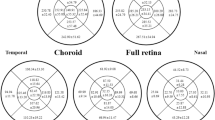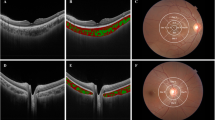Abstract
Purpose
To identify the relationship of macular outward scleral height (MOSH) with axial length (AL), macular choroidal thickness (ChT), peripapillary atrophy (PPA), and optic disc tilt in Chinese adults.
Methods
In this cross-sectional study, 1088 right eyes of 1088 participants were enrolled and assigned into high myopia (HM) and non-HM groups. MOSH was measured in the nasal, temporal, superior, and inferior directions using swept-source optical coherence tomography images. The clinical characteristics of MOSH and the association of MOSH with AL, macular ChT, PPA, and tilt ratio were analysed.
Results
The mean age of participants was 37.31 ± 18.93 years (range, 18–86 years), and the mean AL was 25.78 ± 1.79 mm (range, 21.25–33.09 mm). MOSH was the highest in the temporal direction, followed by the superior, nasal, and inferior directions (all p < 0.001). The MOSH of HM eyes was significantly higher than that of non-HM eyes, and it was positively correlated with AL in the nasal, temporal, and superior directions (all p < 0.001). Macular ChT was independently associated with the average MOSH (B = −0.190, p < 0.001). Nasal MOSH was positively associated with the PPA area and the presence of a tilted optic disc (both p < 0.01). Eyes with a higher MOSH in the superior (odds ratio [OR] = 1.008; p < 0.001) and inferior directions (OR = 1.006; p = 0.009) were more likely to have posterior staphyloma.
Conclusion
MOSH is an early indicator of scleral deformation, and it is correlated positively with AL and negatively with ChT. A higher nasal MOSH is associated with a larger PPA area and the presence of a tilted optic disc. Higher MOSH values in the superior and inferior directions were risk factors for posterior staphyloma.
Clinical trial registration
The study was registered at www.clinicaltrials.gov (Reg. No. NCT03446300).
This is a preview of subscription content, access via your institution
Access options
Subscribe to this journal
Receive 18 print issues and online access
$259.00 per year
only $14.39 per issue
Buy this article
- Purchase on Springer Link
- Instant access to full article PDF
Prices may be subject to local taxes which are calculated during checkout


Similar content being viewed by others
Data availability
The data analysed during the current study are available from the corresponding author upon reasonable request.
References
Holden BA, Fricke TR, Wilson DA, Jong M, Naidoo KS, Sankaridurg P, et al. Global prevalence of myopia and high myopia and temporal trends from 2000 through 2050. Ophthalmology. 2016;123:1036–42.
Fricke TR, Jong M, Naidoo KS, Sankaridurg P, Naduvilath TJ, Ho SM, et al. Global prevalence of visual impairment associated with myopic macular degeneration and temporal trends from 2000 through 2050: systematic review, meta-analysis and modelling. Br J Ophthalmol. 2018;102:855–62.
Sankaridurg P, Tahhan N, Kandel H, Naduvilath T, Zou H, Frick KD, et al. IMI impact of myopia. Invest Ophthalmol Vis Sci. 2021;62:2.
Read SA, Fuss JA, Vincent SJ, Collins MJ, Alonso-Caneiro D. Choroidal changes in human myopia: insights from optical coherence tomography imaging. Clin Exp Optom. 2019;102:270–85.
Zhou LX, Shao L, Xu L, Wei WB, Wang YX, You QS. The relationship between scleral staphyloma and choroidal thinning in highly myopic eyes: the Beijing Eye Study. Sci Rep. 2017;7:9825.
Ikuno Y, Tano Y. Retinal and choroidal biometry in highly myopic eyes with spectral-domain optical coherence tomography. Invest Ophthalmol Vis Sci. 2009;50:3876–80.
Jin P, Zou H, Zhu J, Xu X, Jin J, Chang TC, et al. Choroidal and retinal thickness in children with different refractive status measured by swept-source optical coherence tomography. Am J Ophthalmol. 2016;168:164–76.
Ohno-Matsui K. What is the fundamental nature of pathologic myopia? Retina. 2017;37:1043–8.
Ohno-Matsui K, Jonas JB. Posterior staphyloma in pathologic myopia. Prog Retin Eye Res. 2019;70:99–109.
Ohno-Matsui K. Pathologic myopia. Asia Pac J Ophthalmol (Phila). 2016;5:415–23.
Feng J, Wang R, Yu J, Chen Q, He J, Zhou H, et al. Association between different grades of myopic tractional maculopathy and OCT-based macular scleral deformation. J Clin Med. 2022;11:1599.
Ohno-Matsui K. Proposed classification of posterior staphylomas based on analyses of eye shape by three-dimensional magnetic resonance imaging and wide-field fundus imaging. Ophthalmology. 2014;121:1798–809.
Takahashi A, Ito Y, Iguchi Y, Yasuma TR, Ishikawa K, Terasaki H. Axial length increases and related changes in highly myopic normal eyes with myopic complications in fellow eyes. Retina. 2012;32:127–33.
Hayashi M, Ito Y, Takahashi A, Kawano K, Terasaki H. Scleral thickness in highly myopic eyes measured by enhanced depth imaging optical coherence tomography. Eye (Lond). 2013;27:410–7.
Jo Y, Ikuno Y, Nishida K. Retinoschisis: a predictive factor in vitrectomy for macular holes without retinal detachment in highly myopic eyes. Br J Ophthalmol. 2012;96:197–200.
Ohsugi H, Ikuno Y, Matsuba S, Ohsugi E, Nagasato D, Shoujou T, et al. Morphologic characteristics of macular hole and macular hole retinal detachment associated with extreme myopia. Retina. 2019;39:1312–8.
Park UC, Ma DJ, Ghim WH, Yu HG. Influence of the foveal curvature on myopic macular complications. Sci Rep. 2019;9:16936.
Yamashita T, Sakamoto T, Yoshihara N, Terasaki H, Tanaka M, Kii Y, et al. Correlations between local peripapillary choroidal thickness and axial length, optic disc tilt, and papillo-macular position in young healthy eyes. PLoS One. 2017;12:e0186453.
Fang Y, Yokoi T, Nagaoka N, Shinohara K, Onishi Y, Ishida T, et al. Progression of myopic maculopathy during 18-year follow-up. Ophthalmology. 2018;125:863–77.
Hu G, Chen Q, Xu X, Lv H, Du Y, Wang L, et al. Morphological characteristics of the optic nerve head and choroidal thickness in high myopia. Invest Ophthalmol Vis Sci. 2020;61:46.
Samarawickrama C, Mitchell P, Tong L, Gazzard G, Lim L, Wong TY, et al. Myopia-related optic disc and retinal changes in adolescent children from singapore. Ophthalmology. 2011;118:2050–7.
Moon Y, Lim HT. Relationship between peripapillary atrophy and myopia progression in the eyes of young school children. Eye (Lond). 2021;35:665–71.
Takahashi A, Ito Y, Hayashi M, Kawano K, Terasaki H. Peripapillary crescent and related factors in highly myopic healthy eyes. Jpn J Ophthalmol. 2013;57:233–8.
Ye L, Chen Q, Hu G, Xie J, Lv H, Shi Y, et al. Distribution and association of visual impairment with myopic maculopathy across age groups among highly myopic eyes - based on the new classification system (ATN). Acta Ophthalmol. 2022;100:e957–67.
Xie J, Ye L, Chen Q, Shi Y, Hu G, Yin Y, et al. Choroidal thickness and its association with age, axial length, and refractive error in Chinese Adults. Invest Ophthalmol Vis Sci. 2022;63:34.
Ruiz-Medrano J, Montero JA, Flores-Moreno I, Arias L, García-Layana A, Ruiz-Moreno JM. Myopic maculopathy: current status and proposal for a new classification and grading system (ATN). Prog Retin Eye Res. 2019;69:80–115.
Ikuno Y, Jo Y, Hamasaki T, Tano Y. Ocular risk factors for choroidal neovascularization in pathologic myopia. Invest Ophthalmol Vis Sci. 2010;51:3721–5.
Dai Y, Jonas JB, Huang H, Wang M, Sun X. Microstructure of parapapillary atrophy: beta zone and gamma zone. Invest Ophthalmol Vis Sci. 2013;54:2013–8.
Vianna JR, Malik R, Danthurebandara VM, Sharpe GP, Belliveau AC, Shuba LM, et al. Beta and gamma peripapillary atrophy in myopic eyes with and without glaucoma. Invest Ophthalmol Vis Sci. 2016;57:3103–11.
Tay E, Seah SK, Chan SP, Lim AT, Chew SJ, Foster PJ, et al. Optic disk ovality as an index of tilt and its relationship to myopia and perimetry. Am J Ophthalmol. 2005;139:247–52.
Shin HY, Park HY, Park CK. The effect of myopic optic disc tilt on measurement of spectral-domain optical coherence tomography parameters. Br J Ophthalmol. 2015;99:69–74.
Bennett AG, Rudnicka AR, Edgar DF. Improvements on Littmann’s method of determining the size of retinal features by fundus photography. Graefes Arch Clin Exp Ophthalmol. 1994;232:361–7.
Zhou Y, Song M, Zhou M, Liu Y, Wang F, Sun X. Choroidal and retinal thickness of highly myopic eyes with early stage of myopic chorioretinopathy: tessellation. J Ophthalmol. 2018;2018:2181602.
Wang YX, Panda-Jonas S, Jonas JB. Optic nerve head anatomy in myopia and glaucoma, including parapapillary zones alpha, beta, gamma and delta: Histology and clinical features. Prog Retin Eye Res. 2021;83:100933.
Chen Q, He J, Yin Y, Zhou H, Jiang H, Zhu J, et al. Impact of the morphologic characteristics of optic disc on choroidal thickness in young myopic patients. Invest Ophthalmol Vis Sci. 2019;60:2958–67.
Terasaki H, Yamashita T, Yoshihara N, Kii Y, Tanaka M, Nakao K, et al. Location of tessellations in ocular fundus and their associations with optic disc tilt, optic disc area, and axial length in young healthy eyes. PLoS One. 2016;11:e0156842.
Wen B, Yang G, Cheng J, Jin X, Zhang H, Wang F, et al. Using high-resolution 3D magnetic resonance imaging to quantitatively analyze the shape of eyeballs with high myopia and provide assistance for posterior scleral reinforcement. Ophthalmologica. 2017;238:154–62.
Zhou J, Tu Y, Chen Q, Wei W. Quantitative analysis with volume rendering of pathological myopic eyes by high-resolution three-dimensional magnetic resonance imaging. Medicine (Baltimore). 2020;99:e22685.
Funding
This study was supported by the National Natural Science Foundation of China (Project No. 82171100), the Shanghai Municipal Commission of Health (Public Health System 3-Year Plan - Key Subjects) (Project No. GWV-10.1-XK7, GWV-10.2-YQ40), the Clinical Science and Technology Innovation Project of Shanghai Shenkang Hospital (Project No. SHDC12020127), and the National Key Research and Development Program of China (Project No. 2019YFC0840607, 2022YF2502800). The sponsors or funding organizations had no role in the design or conduct of this research.
Author information
Authors and Affiliations
Contributions
ML and HX interpreted the data and drafted the article; JH and YF analysed the data and substantively revised the article; ML, LY, SZ, JX, and CL conducted the fieldwork for data acquisition; JZ, JH, and YF designed the study. YF and XX made substantial contributions to the conception. All authors read and approved the final manuscript.
Corresponding authors
Ethics declarations
Competing interests
The authors declare no competing interests.
Ethics approval and consent to participate
This study involves human participants and was approved by the Ethics Committee of Shanghai General People’s Hospital, Shanghai, China (Approval number: 2015KY156).
Informed consent
Written informed consent was obtained from each participant
Additional information
Publisher’s note Springer Nature remains neutral with regard to jurisdictional claims in published maps and institutional affiliations.
Supplementary information
Rights and permissions
Springer Nature or its licensor (e.g. a society or other partner) holds exclusive rights to this article under a publishing agreement with the author(s) or other rightsholder(s); author self-archiving of the accepted manuscript version of this article is solely governed by the terms of such publishing agreement and applicable law.
About this article
Cite this article
Li, M., Xu, H., Ye, L. et al. Association of macular outward scleral height with axial length, macular choroidal thickness and morphologic characteristics of the optic disc in Chinese adults. Eye 38, 923–929 (2024). https://doi.org/10.1038/s41433-023-02804-5
Received:
Revised:
Accepted:
Published:
Issue Date:
DOI: https://doi.org/10.1038/s41433-023-02804-5



